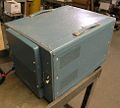556: Difference between revisions
No edit summary |
m (Re-arranged to flow better and fixed typos.) |
||
| Line 1: | Line 1: | ||
The Tektronix 556 is a [[dual-beam scopes|dual-beam scope]], the successor to the Tektronix [[555]]. | The Tektronix 556 is a [[dual-beam scopes|dual-beam scope]], the successor to the Tektronix [[555]]. It uses [[letter-series and 1-series plug-ins]]. A rack-mount version, the RM556 also exists. | ||
It | |||
== Dual-Beam Modes == | == Dual-Beam Modes == | ||
The 556 is a true dual-beam scope and none of the signal | The 556 is a true dual-beam scope and none of the signal path is shared between the two beams. Electrically speaking, the power supply and the calibrator are the only parts that are common to both beams. The 556 has almost complete left-right symmetry, corresponding to upper and lower beams. Although the beams can be operated completely independently, the 556 provides many options for routing signals between the vertical plug-ins, triggers, sweeps, horizontal and vertical amplifiers. For example, a common use for a 556 is to view two simultaneous single-shot events, both sweeps being triggered by one of the traces. For this purpose, the 556 allows the output of one sweep generator to be routed to the horizontal amplifier of the other beam, so it drives both beams. Many other more sophisticated modes are also available. | ||
== Triggering == | == Triggering == | ||
| Line 19: | Line 11: | ||
== Vertical Amplifiers == | == Vertical Amplifiers == | ||
The vertical amplifier of the 556 is solid state except for the input cathode followers ([[12AT7]]) and and the | The vertical amplifier of the 556 is solid state except for the input cathode followers ([[12AT7]]) and and the | ||
output stage ([[8608]]). | output stage ([[8608]]). | ||
== Comparison with the 555 == | |||
The 556 is a one-piece unit whereas the 555 has a the power supply in a separate box. | |||
Triggering and sweep circuitry | |||
is integrated into the 556 mainframe, as opposed to | |||
the removable timing units in the 555. The 556 takes | |||
two [[letter-series and 1-series plug-ins|letter-series or 1-series vertical plug-ins]]. | |||
The bandwidth is 50MHz. | |||
== Comparison with the | == Comparison with the 565 == | ||
The 556 superficially resembles the [[565]], | The 556 superficially resembles the [[565]], | ||
which is is also a dual-beam one-piece scope, but the 565 takes two | which is is also a dual-beam one-piece scope, but the 565 takes two | ||
Revision as of 13:29, 17 April 2014
The Tektronix 556 is a dual-beam scope, the successor to the Tektronix 555. It uses letter-series and 1-series plug-ins. A rack-mount version, the RM556 also exists.
Dual-Beam Modes
The 556 is a true dual-beam scope and none of the signal path is shared between the two beams. Electrically speaking, the power supply and the calibrator are the only parts that are common to both beams. The 556 has almost complete left-right symmetry, corresponding to upper and lower beams. Although the beams can be operated completely independently, the 556 provides many options for routing signals between the vertical plug-ins, triggers, sweeps, horizontal and vertical amplifiers. For example, a common use for a 556 is to view two simultaneous single-shot events, both sweeps being triggered by one of the traces. For this purpose, the 556 allows the output of one sweep generator to be routed to the horizontal amplifier of the other beam, so it drives both beams. Many other more sophisticated modes are also available.
Triggering
The triggering in the 556 is done using tunnel diodes and the trigger circuit sits on its own small PC board just behind the trigger source selection switch.
Vertical Amplifiers
The vertical amplifier of the 556 is solid state except for the input cathode followers (12AT7) and and the output stage (8608).
Comparison with the 555
The 556 is a one-piece unit whereas the 555 has a the power supply in a separate box. Triggering and sweep circuitry is integrated into the 556 mainframe, as opposed to the removable timing units in the 555. The 556 takes two letter-series or 1-series vertical plug-ins. The bandwidth is 50MHz.
Comparison with the 565
The 556 superficially resembles the 565, which is is also a dual-beam one-piece scope, but the 565 takes two 2-series or 3-series vertical plug-ins and has much lower vertical and trigger bandwidth.
The 556, which is wider than the average 500-series scope, fits in the 205 cart.
-
Front view of an RM556.
-
Trigger board contains two tunnel diodes and a reed relay.
-
Top view.
-
Output amplifier driving deflection plates.
-
Neck of 556 CRT. The tube contains two electrically independent guns and vertical and horizontal deflection plates.
-
Rear view
-
Vertical amp schematic
-







